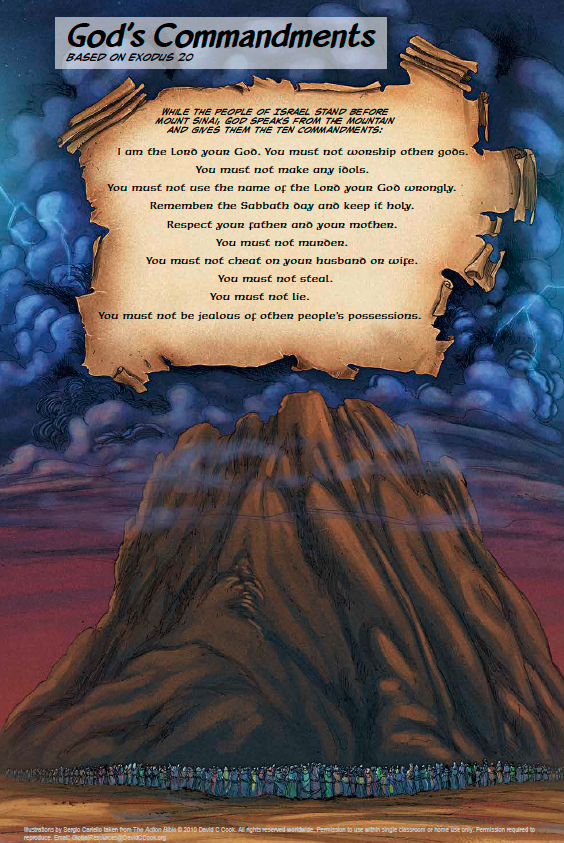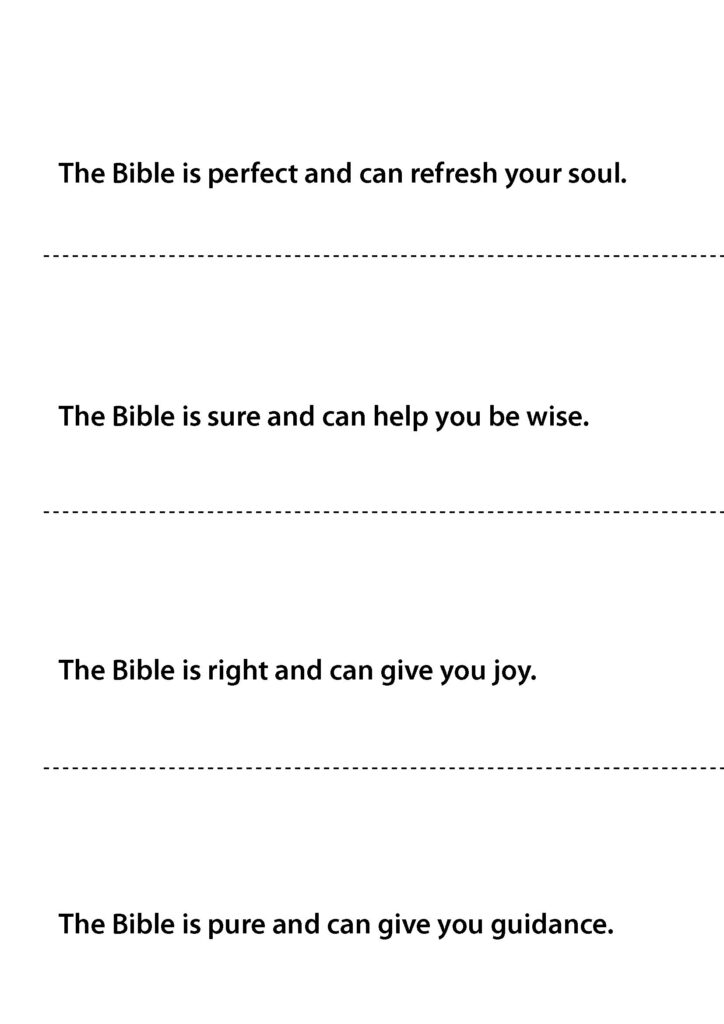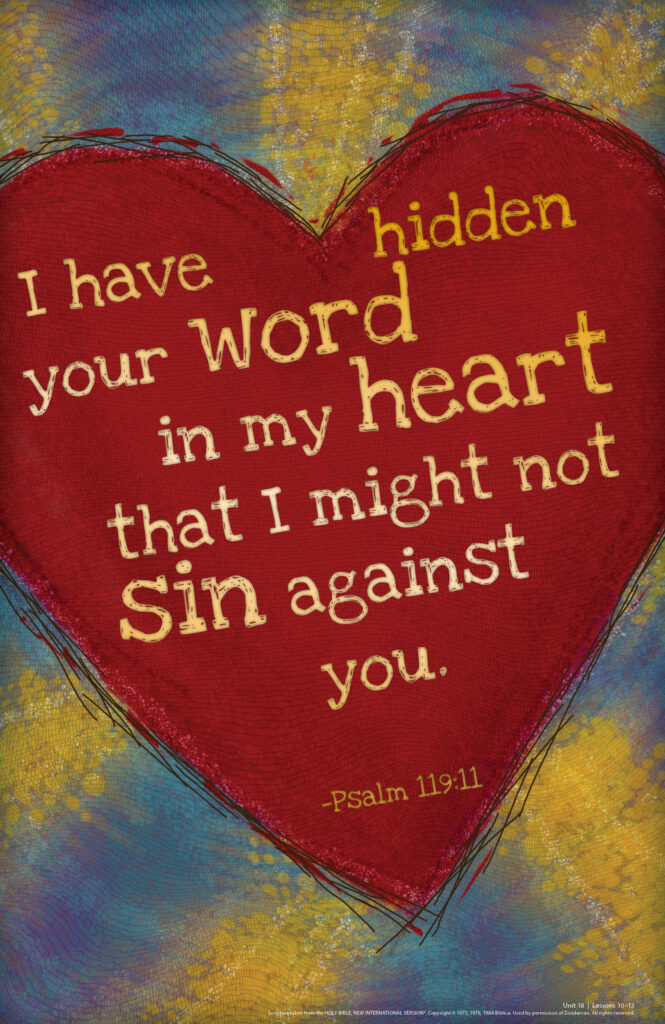During the lesson, the information for you to know is written in regular type, and what we suggest speaking or reading aloud to children is in bold. All resources for this lesson, including the Teacher Guide, Student Page, Family Connection Card, and other resources can be downloaded in a ZIP file by clicking on the following link:
In some lessons you will find "resource articles." These are articles written by experts from around the world to help equip you for your work with children and adolescents. Share them with parents or guardians if you consider it appropriate.
Your word is a lamp for my feet, a light on my path.
Psalm 119:105
Sometimes the path is dark, and we do not know which way to turn. There are decisions to be made, relationships that are broken, situations that are frightening. Yet God’s Word is there, like a welcoming light, showing us the path to take. Through His Word, the Lord guides us, comforts us, and becomes our refuge. His Word truly is a lamp to our feet and a light to our path.
God’s Word—the Bible—is the most important book this world has ever known. It tells the story of God’s redemption through many generations. It shares prophecies that only God’s wisdom could have revealed. It provides guidance for our lives. But most importantly, the Bible reveals God’s character, God’s wisdom, God’s will, and God’s grace. The Bible is an expression of God’s love. Read all of Psalm 119. What words or phrases stand out to you? Write them in a journal, and praise God for what He is saying to you!
Encourage your students to ask their family members, “What is something you have learned that you have never forgotten? How has that changed your life?” Then the students can share that the words of the Bible are meant to be treasured, shared, and stored in our hearts.
Teacher Tip: If possible, email or text the Family Connection Card to the families of your students.
As the students arrive, greet them by name and ask them what was the most meaningful thing they learned about the Bible during the last class.
The more our group meets, the better we know each other. We are learning more about what each of us is like. As we learn more about each other, we begin to understand the truth of who each person is.
Now, let’s imagine that there is a girl in this class. We heard something about this girl and want to know if it is true. But she has moved away and cannot be contacted. So she cannot confirm or deny the story.
Allow the students to respond. After they have shared, add the following ideas if they do not mention them: we find out if anyone saw her doing what we heard she did. We see if the people who know her well believe the story is true. We decide if the story agrees with what we already know about her.
It is an important skill to be able to know whether or not something is true. As you go through life, you will need to know who and what to believe. Here are some questions you can ask to help you determine if something is true:
1. Is there an eyewitness? An eyewitness is someone who personally saw the event take place.
2. Do the majority of people agree? People use their experience, knowledge, and observations to determine truth. When we combine our experience, knowledge, and observations with those of others, we usually make better decisions.
3. Are there any contradictions? When you notice contradictions—statements or behaviors that are opposed to each other or to what you know is true—it helps you know what is false.
Let’s try using these 3 ideas to determine what is true and what is false.
Think of 3 statements about yourself, 2 true and 1 false. The false statement should be realistic. For example, you might say:
I rode a bicycle to get water. (False)
I do not like the color yellow. (True)
I once was bitten by a poisonous snake. (True)
Allow the students to guess.
Answers may include that you looked like you were not being truthful or that they know you well enough to know that it is not true.
Pick 3 volunteers to do this activity. Remind them that their false statements should sound realistic. Ask the same questions after each volunteer shares her 3 statements.
Remember the 3 questions: Is there an eyewitness? Do the majority of people agree? Are there any contradictions? Asking yourself questions like these will help you to be better equipped to know who to trust and what is true.
These 3 questions were also used by Christians in the early church. They looked for eyewitnesses, majority agreement, and contradictions to determine which books should be included in the Bible.
The Old Testament is made up of 39 books that were written before Jesus was born. Some of these books contain stories that were passed down through many generations.
Allow students to share their thoughts. They may say that people prayed and used discernment.
When God first inspired the books of the Old Testament, most people could not read or write. Many of the stories in the Old Testament were shared from 1 person to another and 1 generation to another. We know the Old Testament is true because other historical writings agree with it. For example, inscriptions have been found that mention King David, the shepherd who killed a giant and was chosen by God to be Israel’s king.
In Exodus, God gave 10 laws to Moses for the people of Israel. These laws include “You shall not murder” and “You shall not steal.” These laws were important then, and they are important now. Every culture still has laws against these things because these things harm society and the people in it.
If possible, show The Action Bible image about the 10 Commandments.

Allow students to offer their thoughts. Guide them to realize that this shows us that God is unchanging. He has been the same since the beginning of time and will remain the same until the end. His truth that was written a long time ago is still true today.
We also know the Bible is true because archaeologists have uncovered the remains of buildings and other structures written about in the Bible. Recently, archaeologists discovered the ruins of the wall built by the Jewish people to protect the city of Jerusalem. The story of the construction of this wall is told in the book of Nehemiah.
Allow students to offer their thoughts. Guide them to realize that this shows us that God cares about His people. He shares this with us in the Bible.
We also know the Bible is true because many of the prophecies recorded in it have been fulfilled. For example, in Isaiah 44 and 45 are predictions that a man named Cyrus would help the Jews return to Jerusalem and rebuild the temple. This prophecy was fulfilled when King Cyrus of Persia conquered the Babylonians and declared that the Jews, who were living in exile, could return home to Jerusalem. It is amazing that the Bible announced Cyrus by name more than 100 years before he was born! There are many other prophecies in the Old Testament, including over 100 about Jesus. Many of these prophecies are very detailed, telling of where Jesus would be born, how He would die, and the fact that He would rise again.
Allow students to share their thoughts. Guide them to realize that this shows us that God is faithful. He always fulfills His promises.
Finally, we know the Old Testament is true because it is not filled with contradictions. As we learned last week, even though the Bible was written by about 40 authors, in different countries, over about 1,500 years, it is all unified. It all fits together to tell us how we can have a relationship with God.
Allow students to share their thoughts. Guide them to realize that this shows us that God is all-knowing. He had a plan for all of us before the world was created.
The New Testament is made up of 27 books. These books were written after Christ’s death and resurrection. The early church decided which writings were true and should be included in the Bible by praying and asking the same 3 questions we asked earlier:
1. Is there an eyewitness? For the writing to be included, it had to come from a disciple who had witnessed the life and miracles of Jesus—or someone who knew the disciples.
2. Do the majority of people agree? The writing had to be accepted by most Christians.
3. Are there any contradictions? The writing could not contradict other books of the Bible.
In the New Testament, we have historical books, which include the gospels and Acts. The gospels are Matthew, Mark, Luke, and John. They tell about the life of Jesus. Acts is a book that links the life of Christ with the early history of His church.
Next are the letters, which are also called epistles. These were letters written by Jesus’ disciples to churches or specific people. The letters were written to bring instruction, encouragement, and spiritual support to those who received the letters.
The last book of the Bible is Revelation. This is a book of prophecy that helps the church see what the last days on earth might be like and what we can look forward to in heaven.
Divide the students into 4 groups. Give each of them 1 of the True/Not True statements.

Give the groups about 5 minutes to discuss if their statements are true or not. Then pick a spokesperson from each group to quickly share his group’s conclusion with the class. After all groups have shared, read the following verse aloud from the Bible:
The law of the Lord is perfect, refreshing the soul. The statutes of the Lord are trustworthy, making wise the simple. The precepts of the Lord are right, giving joy to the heart. The commands of the Lord are radiant, giving light to the eyes.
Psalm 19:7–8
These verses tell us that God’s Word itself talks about how true and right it is. It revives us, gives us life, makes us wise, brings us joy, and guides us. God’s Word shows us His love for us.
The Bible has remained true throughout all history. The Bible is precious because God speaks through it. He wants to speak to you. Maybe you do not know God yet. Maybe you still have questions. If you seek God, you will find Him.
I have hidden your word in my heart that I might not sin against you.
Psalm 119:11

Allow students to share their answers. They may say that by reading or listening to the Bible more they will understand God more and know how to live in ways that honor Him.
The Bible is God’s Word to us. He wants us to remember what He has said. He wants to provide light to the paths where we walk. He wants us to know His Word so it can help guide us. Let’s memorize this verse now.
Optional: If you are using the Student Pages, the students can complete the pages to help them memorize the verse.

Repeat the verse aloud with your students. Allow them to come up with a clapping rhythm to help them remember it. Repeat it several times.
We will repeat this verse aloud. As we do this, we will make a pile with these rocks. For each word, we will put a rock on the pile. A good way to memorize things is to do physical actions with the words. This is what we will do with the rocks.
Invite the students to work together to build a pile with the rocks. A different student will place 1 rock on the pile as the class says a word of the verse. The last rock is for the Bible reference. After they have finished, share the following:
Piles of rocks like these are called “cairns.” They are used in many places of the world to mark trails or roads. They lead explorers in the right direction, just like the verses of the Bible can lead you. Whether you have a Bible available to read or not, you can take what you learn from God’s Word and hide it in your heart. God wants you to know Him. He loves you very much.
As the students stand, pray this blessing based on Psalm 119:105 over them:
Blessing: May you desire to know God more and more. May His Word be a light on your path as you seek His truth in your life.
Lead your students in singing this quarter’s song if possible.
Life on Life ©2020 David C Cook. Reproducible for home or classroom use only. All other uses require written permission from David C Cook [email protected]. All rights reserved.